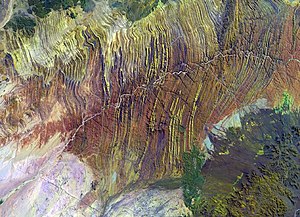
The Ugab River is an ephemeral river that only flows above the surface of its sandy bed a few days each year, but even during much of the dry season its subterranean water surfaces as pools in places, and provides an important resource for species in the Damaraland region of northern Namibia. The Ugab's mean run-off is roughly 20 million cubic metres per annum.[1]
21°11′S 13°37′E / 21.183°S 13.617°E
The Ugab River's large subterranean water content makes it a major Namibian River. Stretching for almost 500 km, the river provides water for species such as the rare desert elephant as well as giraffe, mountain zebra and the largest population of free roaming black rhinoceroses in the world. The Ugab Wilderness Area was established here to protect the future of these rare animals.
People can trek the length of the sandy river, passing local Herero farmers and the pink granite 'inselbergs' (islands of rock left behind after volcanic activity) dotted throughout the region. These bizarre stones have been shaped over the years into vaguely recognisable shapes, some look like toadstools, while others are eerie hollow structures known as the 'Petrified Ghosts'.
The Brandberg White lady lodge is also build around this river, the river is famous for its variety of game,birds, facinating reptiles and insects.[[user:Vernon eichab|vernoneichab]] (talk) 19:04, 2 October 2011 (UTC)
Quite a few plants grow there; much of the visible vegetation is the exotic wild tobacco, Nicotiana glauca. Also found there indigenously are some stunted acacia trees, nara bushes, Acanthosicyos horridus, with their (almost leafless) spiky green stems, and improbably large melons.
References edit
- ^ "ELECTIONS 2010: Erongo regional profile". New Era. 16 November 2010.
2.Brandberg white lady lodge[1]
- ^ Brandberg white lady lodge.Retrieved September 30,2011,from http://www.brandbergwllodge.com/Activities.html